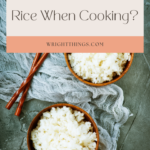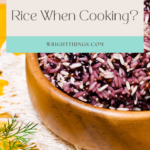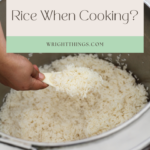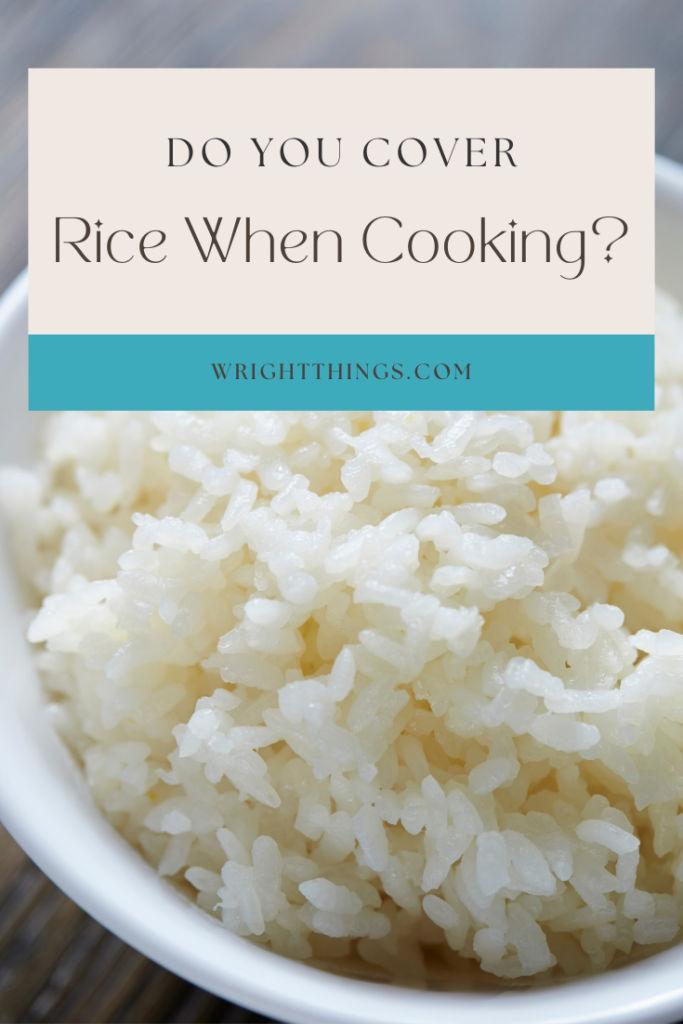If you’ve ever cooked rice, then you know there are a multitude of questions that come up. Should I cover it? What temperature should I cook it at? How much water should I use? Today we’re going to focus on the question of whether or not you should cover your pot of rice while cooking. Read on to find out!
There are a few variables that should help you to know if you need to cover your rice when cooking.
The answer is, it depends on a few factors. If you’re using a traditional stovetop method to cook your rice, then it’s best to leave the lid off unless the directions specify otherwise. Covering the pot traps in steam and can cause your rice to become soggy or clumpy.
However, if you’re cooking your rice in the oven, then you should cover the pot with a lid or aluminum foil to contain the steam.
What about pressure cookers? When it comes to pressure cookers, it’s best to leave the lid on and seal it shut as directed in your recipe. This will ensure that pressure builds up inside the cooker and cooks the rice. If you don’t shut the lid, the pressure can’t build up in the Instant Pot or pressure cooker and will not properly cook your rice.
Why You Should Cover Your Pot of Rice When Cooking
The main reason why people opt to cover their pot of rice while cooking is that it allows the steam and heat to be trapped in the pot, thus speeding up the cooking process. A covered pot also helps ensure that all the liquid gets absorbed by the grains and prevents them from boiling over.
This will help prevent burning and sticking, leading to better-tasting rice. In addition, covering your pot can help keep your kitchen clean by reducing splattering and spills over the stovetop or other cooking surface.
Why You May Not Want to Cover Your Pot of Rice While Cooking
On the flip side, some people prefer not to cover their pot of rice when cooking because they want a fluffy texture rather than a sticky one. Uncovered pots allow steam to escape during the cooking process which can result in a drier texture for your grains once cooked through.
Additionally, if you prefer more flavor in your rice, leaving it uncovered allows any spices or herbs you add during cooking time to mix with steam and permeate throughout your dish as it cooks. And, you don’t have to worry about opening the top and letting trapped steam escape since it is already doing that.
Do You Need to Rinse Rice Before Cooking?
Whether or not you need to rinse your rice before cooking will depend on the type of rice you’re using. For long-grain, basmati, and jasmine rice, it’s recommended that you rinse them in cold water before cooking to remove excess starch.
This helps prevent clumping and makes the grains fluffier once cooked. Short-grain and quick-cooking rice don’t need to be rinsed as they already contain a lower amount of starch.
Rice is an incredibly versatile food that can be used in a variety of recipes. There are many different types of rice, each with its own unique characteristics and flavors.
Brown rice, for instance, has a nuttier flavor and chewy texture compared to white rice and takes longer to cook. It’s recommended to rinse brown rice before cooking. This helps remove any dirt and debris, as well as excess starch. However, you may want to try soaking brown rice for 30 minutes or more in cold water before cooking – this will help reduce the cook time and make the grains softer and fluffier once cooked.
Wild rice is another type of grain that has a nutty flavor, but is usually more expensive than other varieties. It takes about 45 minutes to cook wild rice, making it an ideal option for recipes that require longer cooking times. So, should you rinse wild rice before cooking it? Yes, it’s a good idea to rinse wild rice before cooking.
Rinsing the rice will help remove impurities and debris that may be in the rice from packaging or other reasons. It can also help reduce the amount of starch that gets released into the water when cooking, resulting in better texture and flavor for your finished dish.
Another type of rice is Arborio rice, which is a short-grain variety commonly used in Italian dishes such as risotto. This type of rice needs to be rinsed before cooking because it contains high amounts of starch that can make the grains clumpy when cooked.
When it comes to quick-cooking rices such as minute or pre-cooked white or brown varieties, they don’t need to be rinsed prior to cooking since they already contain a lower amount of starch. However, it’s still recommended that you rinse them if possible since this will help remove any dust particles or residue from the packaging that could potentially make your dish less appealing.
In addition to all the different types of rices available on the market today there are also ancient grains such as quinoa, amaranth, millet, buckwheat and teff that can be cooked much like traditional grains do but are packed with additional nutrients and fiber making them great additions to any diet plan.
Since ancient grains tend to have less starch content than traditional varieties like brown or white rice they don’t need to be rinsed.
What is the Ratio of Water to Rice?
Keep in mind that the recommendations shared below are just things you can use as a general rule, always refer to your own recipe.
The ratio of water to rice will depend on the type of rice you’re using and how you’re cooking it. Generally, it’s recommended that for every cup of long-grain, basmati rice f, or jasmine rice you use two cups of liquid (water or broth). For short-grain and quick-cooking rice, a 1:1 ratio of cups of water to cup of rice is best.
However, if you prefer your grains softer or firmer then adjust the amount of liquid accordingly to make the perfect rice for whatever dish you want to serve it in or serve it with. You can play with the recipe until your find the right amount of water if you aren’t following a tried and tested recipe or using the package instructions since there are many different ways to prepare your various types of rice.
How Long to Cook White Rice?
You don’t need a fancy rice cooker to make perfect fluffy rice. There are various other methods to cook rice to avoid mushy rice. Just be sure to get your rice water ratio correct and use the appropriate heat level to cook your rice over.
If you’re cooking long-grain white rice on the stovetop, it should take around 20 minutes — 10 minutes of simmering and 10 minutes of resting. For short-grain white rice, a cook time of around 15 minutes is ideal — 8 minutes of simmering and 7 minutes of resting.
If you’re cooking quick-cooking white rice, the cook time is even shorter — just 5 minutes of simmering and 10 minutes of rest.
Letting the rice rest and then using a fork to fluff it is important to helping it get to the proper texture and letting it soak up all of the excess water.
If you find that you have more rice in the pan or pot that you are not immediately using, I like to toss the pot lid back on while I use or eat whatever rice I want to from the container and let the rice rest and try to soak up any extra water as it can. When I’m ready to store the leftover rice, I’ll check and see if there is any water left on the bottom of the pan and store it with leftovers in the fridge to make reheating easier later.
In a pressure cooker or electric multicooker (like an Instant Pot), long-grain white rice should cook in around 8 minutes, while short-grain needs 7 minutes. Quick-cooking only requires 4 minutes.
No matter how you’re cooking white rice, it’s important to rinse the grains in a strainer before adding them to your pot of water. This step won’t affect the cook time, but will help remove extra starch and ensure perfectly fluffy cooked rice.
For brown rice fans looking to cook in an Instant Pot, you’ll need at least 22 minutes of cook time. Start by rinsing the rice in a fine mesh strainer, just like you would with other rice. Then add 1 cup of brown rice to 1 1/2 cups of hot water and season with salt. Lock the lid into place, select the “Rice” setting, and cook until done.
Some rices will say to use cool water for your rice, but you could use chicken broth, chicken stock, or other flavored stock or broth that would go with your Asian dishes or other meals to help bring more health benefits and this is the easiest way to expand the flavor profile of your rice.
I should end this by reminding you to follow your rice recipes and cook according to whatever those directions say for your long-grain rice or short-grain rice. Each written recipe has usually been tested and has a suggested cook time. The cook times listed above are just suggestions.
How to store uncooked rice?
Store uncooked rice in an airtight container or resealable bag and keep it away from direct sunlight. We like to store our uncooked rice in a mason jar or dry storage bucket with a tight-fitting lid.
White rice will last for up to a year, while brown rice should be used within six months. If you plan on storing your uncooked grains for longer than that, place them in the freezer instead.
How Long Will Cooked Rice Keep?
Cooked rice will stay fresh in the fridge for up to four days. Make sure you store it in an airtight container and reheat your cooked rice with a few tablespoons of water when ready to eat. Adding the water helps bring the rice “back to life” instead of resulting in dried kernels of rice on your plate.
You can also freeze cooked rice for up to six months – just defrost before reheating! It may be helpful to use a wooden spoon to break apart any chunks of rice before reheating.
How to Reheat Rice?
The best way to reheat rice is in the microwave, stirring every minute or so. Alternatively, you can also put it in a saucepan over low heat for about 5 minutes. Just make sure to watch it closely and stir often to prevent burning. For best results, add a few tablespoons of water before reheating as this will help to restore the rice’s moisture.
So what’s the verdict? Ultimately, whether or not you decide to cover your pot of rice when cooking is up to personal preference—so experiment! Try both ways and see which option yields better results for you in terms of texture and flavor. As long as you’re using enough cooking liquid and maintaining an appropriate temperature level at all times (if using a stovetop), then either way will work just fine! Enjoy!





